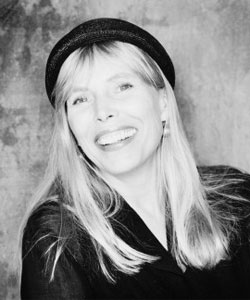They first met in 1966. Malka Marom was a wife, mother, and popular Canadian folk singer in the duo Malka & Joso. Her seemingly idyllic life was unraveling as she walked into a dimly lit coffeehouse in Toronto. As she listened to the young singer, Malka felt as though this woman knew her. “And the more she sang, the more her voice became my own.” She was amazed to discover that the woman wrote her own material. She felt certain that she’d become a star. She was right.
 As a journalist seven years later, Malka landed the first of three in-depth interviews with that young woman. It marked the beginning of a close friendship that spanned decades. Joni Mitchel: In Her Own Words allows the reader to sit on the sofa while these two kindred spirits reflect on the life of an extraordinary artist.
As a journalist seven years later, Malka landed the first of three in-depth interviews with that young woman. It marked the beginning of a close friendship that spanned decades. Joni Mitchel: In Her Own Words allows the reader to sit on the sofa while these two kindred spirits reflect on the life of an extraordinary artist.
As I read through the material, I took note of several themes that characterized Joni Mitchell’s artistic journey.
She didn’t get caught up in the world’s judgment; she held to her own inner compass. As a young child, Joni was labeled a mediocre student by her teachers. Yet Joni noticed that the “good students” were those who simply spit back what the teacher told them. Joni was interested in the unasked question, or the question that didn’t have an easy answer. So their labels didn’t mean much to her. Years later, Joni drew criticism when her work didn’t attain the expected level of commercial success. She didn’t get worked up about it. She accepted the fact that people wouldn’t always appreciate her artistic growth. She takes pride in her “experimentiveness.”
She identified with being an artist. While her grades may not have inspired enthusiasm, she discovered her skill as a painter by winning an art contest. (She drew the best dog house.) That discovery provided another avenue to distance herself from her banal education. She also leveraged her gift to quell anxiety. When a teacher suggested that she could also paint with words, a poet was born.
She was endlessly curious and inventive. She didn’t want to learn the masters when playing piano; she wanted to write her own material. She played London Bridge is Falling Down backwards to yield a far more interesting sound. She kept fiddling with the tuning on her guitar so that she could continue to explore and re-discover the instrument. She craved freshness and never wanted to sound like anybody else. When asked if she ever feared that the creative well would run dry, she responded: “As long as you still have questions… the muse has got to be there.”
She plumbed the depth of her experience and her emotions to create authentic material. She deemed herself ultra-sensitive, perceiving things that others do not. When writing a song, she was open to the encounter, giving herself the space to experience the miraculous. “The muse passes through you as you allow yourself to experience.” Recording was a process of discovery, searching more and more for reality, not an affectation. She was also keen to experience her songs as she performed them. If she felt that she’d gone on auto-pilot and started thinking about 100 different things, she’d stop.
She made difficult choices in service of her art. Joni and her first husband became a successful folk duo. When she realized that she couldn’t grow with him, she set out on her own. She refused to be a formulaic recording artist who produced derivative material (even of herself!) for the sake of fame or fortune. She turned down highly lucrative performance gigs if the venue, material, or vibe didn’t align with her artistic integrity.
She was never addicted to applause or honorariums. She was driven by her muse, by the need to explore. She felt it was important to “keep a carrot in front of your nose for growth.” At the end of the day, the art was the thing.
“Freedom for me is a luxury of being able to follow the path of your heart, to keep the magic in your life. Freedom is necessary for me in order to create, and if I cannot create, I don’t feel alive.”
– Joni Mitchell